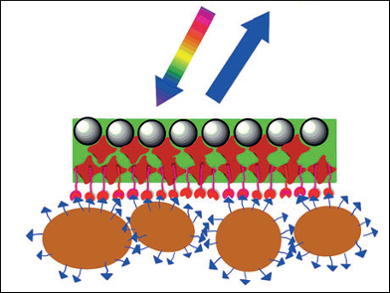The sensitive and selective detection of microbial pathogens is often hindered by time-consuming and complex methods. Sanford Asher, Xinyu Liu, and a team at the University of Pittsburgh, PA, USA, set out to create a simple sensor that relies on the combination of two-dimensional photonic crystals (2D PCs) with hydrogels formed from carbohydrate-binding proteins.
The researchers took the lectin Concanavalin A (Con A), which binds to mannans on cell surfaces, and crosslinked it to form Con A hydrogels. 2D photonic crystals were then embedded on the hydrogel surface. The resulting sensor is selective to the microbe Candida albicans.
When Concanavalin A binds to the surface mannans of C. albicans, the particle spacing of the PCs decreases and there is a blue-shift in the refracted light. This change can either be detected by the naked eye or measured spectroscopically. The Con A–mannan interaction is key to the specificity: the sensor showed negligible response with bacteria that lack surface mannans, such as E. coli, and a BSA protein hydrogel sensor control did not respond to the presence of C. albicans.
This combination of a 2D photonic crystal array with protein hydrogels leads to specific sensors with a shorter response time compared to filtration culture methods. The team is working towards hydrogels with a lower degree of crosslinking to increase the sensitivity and decrease the detection times.
- A Photonic Crystal Protein Hydrogel Sensor for Candida albicans,
Zhongyu Cai, Daniel H. Kwak, David Punihaole, Zhenmin Hong, Sachin S. Velankar, Xinyu Liu, Sanford A. Asher,
Angew. Chem. Int. Ed. 2015.
DOI: 10.1002/anie.201506205




